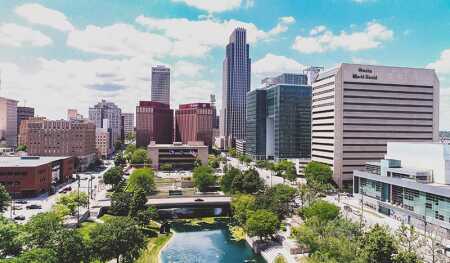Car manufacturers, including General Motors, Tesla, and Ford, and tech companies like Google and Uber are racing to get fully autonomous vehicles (AVs) on U.S. roads. Among the cities vying to be testing grounds for AV pilot programs are Pittsburgh, Tempe, Sacramento, and Portland, Oregon.
At the same time, concerns have been raised that driverless technology will generate more congestion and sprawl.
A new study by INRIX, a data analytics company focused on traffic and automotive industry data, looks at which of the 50 largest U.S. cities would benefit the most from shared AVs.
“We hear a lot about which cities are best prepared for autonomous vehicles,” says Avery Ash, AV market strategist at INRIX. “But prepared is loosely defined as who’s most receptive to the idea or which mayors are trying to attract autonomous-vehicle manufacturers. We wanted to look instead at which city’s travel patterns are best suited for highly autonomous vehicles being deployed in a fleet format much the way we use ride sharing.”
The top-ranked cities are perhaps not what one would expect. New Orleans takes the number-one spot, followed by Albuquerque and Tucson. Portland, Oregon, and Omaha round out the top five.
To create the ranking, INRIX looked at one year of travel data—nearly 1.3 billion trips in the 50 cities. Trips were scored according to their length and proximity to downtown. Short trips that stayed close to the city center scored higher.
Short, central trips will better facilitate shared rides in a full car than will longer trips into the far reaches of a city or the suburbs, Ash says. INRIX found that cities at the bottom of the ranking, including Fort Worth and Baltimore, had a higher proportion of long trips that might not be as good for sharing, at least with existing infrastructure.
David Bragg, a managing director with research firm Green Street Advisors and author of Transportation Revolution, is more optimistic about the positive impact on longer trips in shared vehicles.
“With vehicle-to-vehicle communication, trips should become quicker and also more comfortable as things like stop signs and stoplights largely are eliminated,” he says. “So some of these longer trips will be enabled by the technology. At the same time, with services like Uber Pool and Lyft Line, we’re hopefully cutting the actual number of trips, when people share cars, either on shorter or longer trips. “
Ash thinks cities have plenty of potential to deploy AVs selectively in areas where they would work best. If it does not make sense to have AVs taking long trips into the suburbs, that does not mean they cannot be circulating downtown, he says. “It shouldn’t just be thumbs-up or thumbs-down of autonomous vehicles on the road in a city,” he says.
Cities need to figure out which problems AVs need to solve, Ash says. It could be first-mile/last-mile connectivity to transit hubs, or perhaps a mobility solution for young people and old people who cannot drive themselves.
“Cities need to be asking themselves, ‘Why?’ It’s not enough to have technology for the sake of technology,” he says. “You need to look at ways AVs can address constituents’ challenges or specific congestion problems.
“We do believe the likelihood is there will be benefits to this technology. But if you’re not structuring things with a clear deployment plan, you’re not likely to achieve them.”
Bragg thinks another part of the discussion is the impact of AVs on parking. The United States has 150 billion square feet (14 billion sq m) of parking space—about four spaces for every car on the road. Repurposing private parking and street parking could have a major impact on how cities work.
“I agree the markets where it matters the most are where people use public transportation the least,” says Bragg. “But there is also the potential for people to go great distances in relative comfort.”





